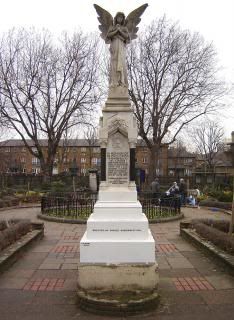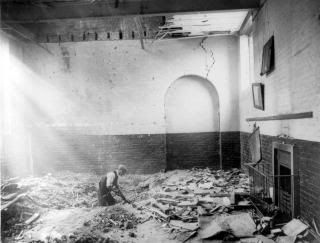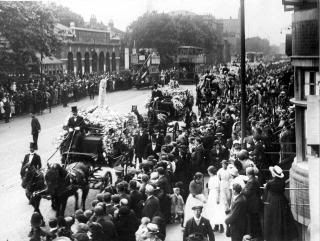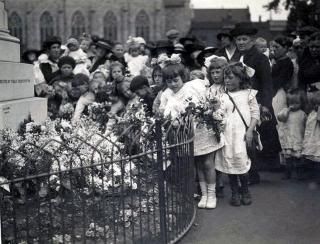Upper North Street School Bombing
In June 1917 the 'Great' war had been waging for three years, but that was away in France. In the eastend of London the 13th of June started like any other. No-one could ever have imagined that it would end in a tragedy that would send shock and sadness throughout the country. It affected everyone even the King himself.
It was mid morning when people began to notice something strange in the summer sky. By his time in the war the people were used to Zeppelin raids, but this time it was different. Some people described them as looking like dragonflies. As they came nearer it became clear they were planes fourteen in number, and as they flew they dropped bombs leaving devistation in their wake. As they flew overhead one witness said ''the sun had been shining but it seemed to go out in a roar of thunder''. This was the first fixed wing bombing raid by fixed wings aircraft on women and children.
Twice before the Gotha's of the 'English Squadron' led by Squadron Commander Hauptmann Ernst Branderberg had tried to bomb Britan, this time when they reurned to base leaving a hundred and sixty two people dead and over five hundred injured they probably counted their mission a success. Amongst those killed and injured were the children of Upper North Street school.
Whether he pilot recognised he building he hit was a school or not will never be known. What is known is that the bomb landed on the roof of he school then continued through o the top floor where the girls were taught, it carried on through the second floor which was the boys classroom and finally carried on to the ground floor before exploding in the infants classroom.
Local people, including the mothers of the children rushed to the school to join the teachers digging in the
rubble praying all the time they would find their child alive. The injured were taken to hopitals and those killed were taken to the morque with their greiving mothers. The women of the eastend, like women elsewhere had somewhere in their hearts prepared themselves that their menfolk might never come back, but not their children. Never during their darkest moments did they believe that their children were in any danger in the safety of their school.
The children who lost their lives that day were:
Louise Annie Acampora aged 5 ... Alfred Ernest Batt aged 5 ... Leaonard Charles Barford aged 5 ... John Percy Brennan aged 5 ... William Thomas Henry Challen aged 4 ... Vera May Clayson aged 5 ... Alice Maud Cross aged 5 ... William Hollis aged 5 ... George Albert Hyde aged 5 ... Grace Jones aged 5 ... Rose Martin aged 11 ... George Morris aged 6 ... Edwin Cecil William Powell aged 12 ... Robert Stimson aged 5 ... Elizabeth Taylor aged 5 ... Rose Tuffin aged 5 ... Frank Winfield aged 5 ... Florence L Woods aged 5.
A week later on the twentieth of June when the funerals were being held hundreds lined the streets in silent respect. Over six hundred wreaths were sent from all over the world. The funeral service at the parish church of All Saints. Among the mourners were many children who had survived the attack.
The Bishop of London conducted the service and knowing what was being demanded on the streets he said ''Little did we expect, after 2000 years of teaching Christianity, that war would be made on women and children ... we must be careful that indignation drives us into the right action. There is much looseness of thought and phrases about retribution. I do not believe that the mourners wish that sixteen German babies should lie dead to avenge their own.
He also read out a message from King George V who visited the eastend immediately after the tragedy.The message read that he and, with Queen Mary. were thinking of the childrens parents and ''their saddened homes, especially today when the bodies of their little ones were laid to rest''. The Kings message went on ''of young innocent lives, at all times pathetic, is made more so that ever in these tragic circumstances. Their Majesties pray that the mourners may be blessed with God's help and comfort in their sorrow''.
The mayor and local MP Will Crooks decided it would be fitting to set up a memorial fund, The memorisl stands in Poplar recreation park. it was paid for by public donations and unveiled on the twentieth of June 1919.
April 2014 From East London Advertiser
Thieves have stolen trees from a WWI memorial just days after they were planted to mark the deaths of 18 children killed in a German wartime bombing raid.
The trees were placed by Mayor Lutfur Rahman in Trinity Gardens, Poplar, near the site of the bombing of Upper North Street School in 1917 in a ceremony on April 1 attended by the Royal British Legion.
But within days, residents alerted the Advertiser that some of the trees had gone missing, along with a memorial plaque for the site.
Tower Hamlets Council confirmed the trees had been stolen, but said they would be quickly replaced.
A spokeman said: “We are saddened to find that three out of the 10 elm trees along with the black poplar tree planted by the council in Trinity Gardens to commemorate the First World War-era bombing of a local school have been taken.
“We will be looking to replant the missing trees as soon as possible.”
She said no crime had been reported to the Met police as the trees will be replaced, adding: “Parks staff have been informed to keep a close eye on the trees once they are replanted.”
She added the memorial plaque had yet to be “concreted” and was removed from the site by the council after the mayor’s ceremony.
Upper North Street School was struck by one of the first aerial bombings of the First World War on June 13, 1917. The attack targeted the East India and Millwall docks.








